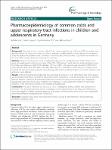Pharmacoepidemiology of common colds and upper respiratory tract infections in children and adolescents in Germany
Eckel, Nathalie
Sarganas, Giselle
Wolf, Ingrid-Katharina
Knopf, Hildtraud
Background: Medicines to treat common colds (CC) and upper respiratory tract infections (URTI) are widely used among children, but there are only few data about treatments actually applied for these diseases. In the present study we analyze the prevalence and correlations of self-medicated and prescribed drug use for the treatment of CCs and URTIs among children and adolescents in Germany. Methods: Medicine use during the week preceding the interview was recorded among 17,450 children (0–17 years) who participated in the drug interview of the 2003–2006 German Health Interview and Examination Survey for Children and Adolescents (KiGGS). The definition of CCs and URTIs in the present study included the WHO-ICD-10 codes J00, J01.0, J01.9, J02.0, J02.9, J03.0, J03.9, J04.0, J06.8, J06.9, J11.1, J11.8, R05 and R07.0. Using the complex sample method, the prevalence and associated socio-demographic factors of self-medication, prescribed medicines and antibiotics were defined. Results: 13.8% of the participating girls and boys use drugs to treat a CC or an URTI. About 50% of this group use prescribed medications. Among the users of prescribed medication, 11.5% use antibiotics for the treatment of these diseases. Looking at all prescribed medicines we find associations with younger age, immigration background, and lower social status. Antibiotic use in particular is associated with female sex, higher age, residency in the former East Germany and immigration background. Conclusions: The use of medicines to treat CCs or URTIs is widespread among children and adolescents in Germany. Thus, longitudinal studies should investigate the risks associated with this drug use. Differences in socio-demographic variables regarding exposure to antibiotic use indicate that there could be an implausible prescribing behavior among physicians in Germany.
No license information

